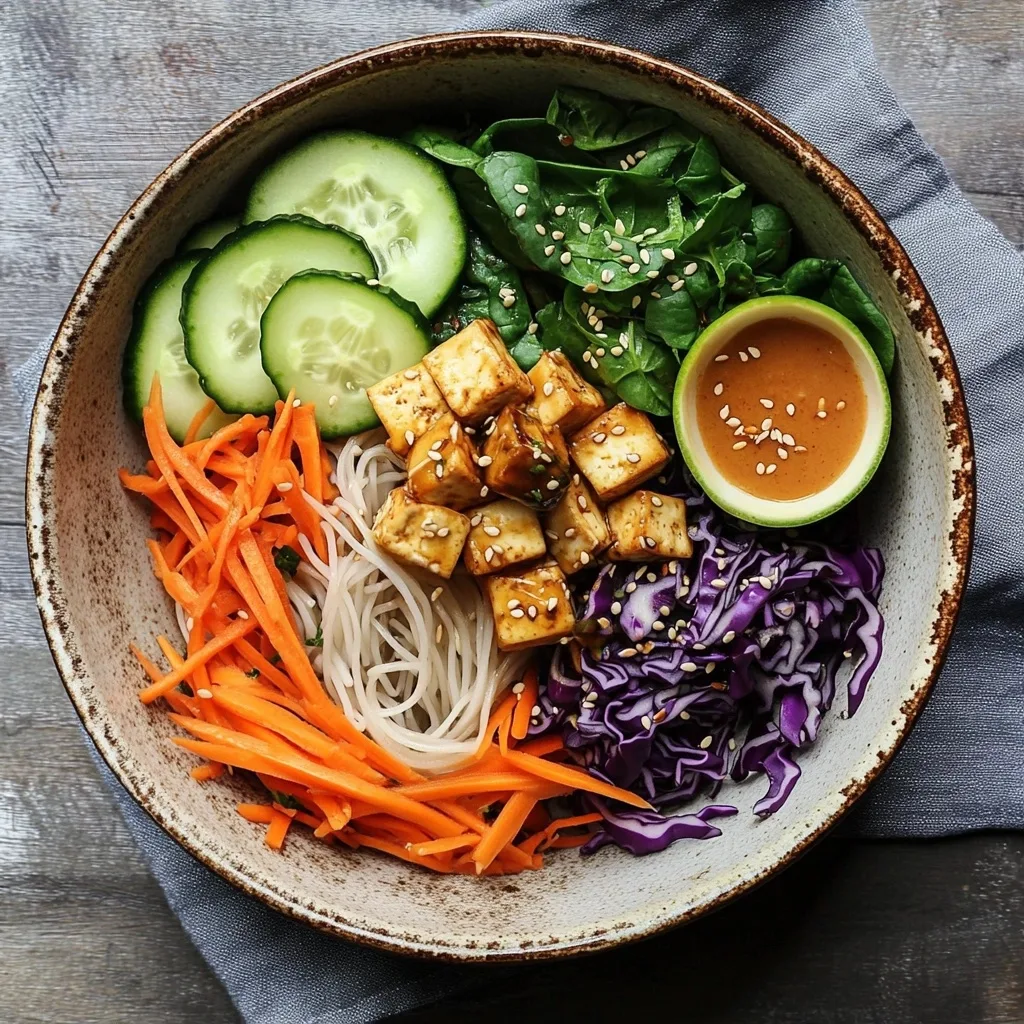There’s something almost magical about a perfectly assembled Buddha Noodle Bowl. With its colorful array of fresh vegetables, protein-rich tofu, tender noodles, and creamy peanut-ginger sauce, this dish isn’t just a feast for your stomach—it’s a feast for your eyes too. If you’re looking for a meal that’s as nutritious as it is satisfying, this Buddha Noodle Bowl recipe deserves a prime spot in your weeknight dinner rotation.
Drawing inspiration from various Asian cuisines, Buddha Noodle Bowls represent the best of balanced eating: whole grains, lean protein, plenty of vegetables, and a flavorful sauce that ties everything together. Unlike complicated meals that require perfect timing to ensure all components finish cooking simultaneously, these bowls are refreshingly forgiving. You can prep ingredients in advance, adjust portions to your liking, and even customize components based on dietary preferences.
Join me as we explore the art of crafting the perfect Buddha Noodle Bowl—from choosing the best ingredients to mastering the irresistible peanut-ginger sauce that will have everyone at your table asking for seconds.
What Makes a Perfect Buddha Noodle Bowl?
The concept of a Buddha Noodle Bowl comes from the Buddhist tradition of balance and mindfulness in eating. Just as Buddha carried a bowl to collect small amounts of food, these modern interpretations feature a harmonious mix of ingredients artfully arranged in a single vessel. The beauty of a Buddha Noodle Bowl lies in its thoughtful composition—each component brings unique flavors, textures, and nutrients to create a truly satisfying meal.
What sets a great Buddha Noodle Bowl apart from an ordinary one? It’s all about balance across several dimensions:
Color: A rainbow of vegetables doesn’t just look Instagram-worthy—it ensures you’re getting a diverse range of nutrients. The vibrant reds of bell peppers, deep greens of spinach, and purples of cabbage aren’t just pretty; they’re packed with different antioxidants and phytonutrients.
Texture: The interplay of crisp raw vegetables, tender-chewy noodles, and golden-crisp tofu creates a sensory experience that keeps each bite interesting. This textural contrast is what makes Buddha Noodle Bowls so satisfying compared to simpler meals.
Flavor profiles: The fresh, raw vegetables provide crispness and natural sweetness. The tofu offers a protein-rich canvas that absorbs the savory sesame oil. And the peanut-ginger sauce ties everything together with its perfect balance of salty, sweet, tangy, and (optionally) spicy notes.
Nutrition: Without explicitly trying to be “health food,” Buddha Noodle Bowls naturally deliver an impressive nutritional profile. You’ll get complex carbohydrates from the noodles, plant-based protein from the tofu, healthy fats from the sesame oil and peanut butter, and a wealth of vitamins, minerals, and fiber from the colorful vegetables.
The result is a meal that leaves you feeling nourished rather than stuffed—energized rather than lethargic. It’s comfort food that actually makes you feel good afterward.
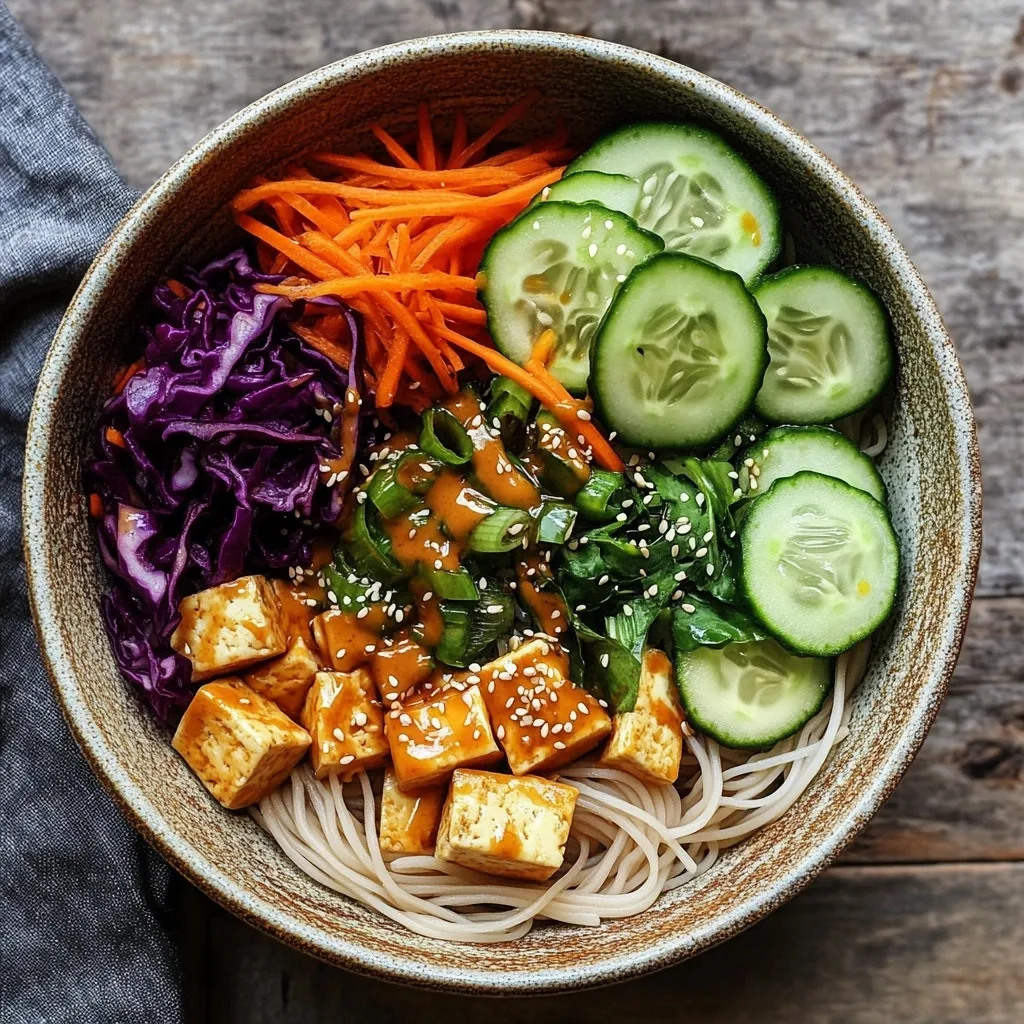
Essential Ingredients for Your Buddha Noodle Bowl
The beauty of Buddha Noodle Bowls lies partly in their flexibility, but certain key ingredients create that signature experience. Let’s break down the components that make this dish special:
The Noodle Foundation
Rice noodles form the base of our Buddha Noodle Bowl, offering a delicate texture and subtle flavor that harmonizes beautifully with the other ingredients. Their quick cooking time (typically just 4-6 minutes) makes them ideal for weeknight meals. If you’re new to rice noodles, you’ll find them in the international aisle of most grocery stores, usually in different widths—medium width works perfectly for this recipe.
Don’t feel limited to rice noodles, though. This dish works beautifully with:
- Soba noodles (buckwheat)
- Udon noodles (thick wheat)
- Ramen noodles (thin wheat)
- Even spiralized vegetable “noodles” for a grain-free option
The key is tossing your cooked noodles with a bit of sesame oil to prevent sticking—a step many home cooks overlook. This small addition keeps your noodles separate and adds a subtle nutty flavor that complements the dish beautifully.
Protein That Pleases
While our recipe features extra-firm tofu for its excellent flavor-absorbing properties and plant-based protein content, the Buddha Noodle Bowl concept adapts easily to other proteins:
- Thinly sliced grilled chicken
- Sautéed shrimp
- Seared tuna
- Tempeh or seitan for other plant-based options
The secret to perfect tofu is in the preparation—pressing out excess water allows it to absorb more flavor and achieve a better texture when pan-fried. For best results, wrap your tofu block in paper towels, place a cutting board on top, and weigh it down with a heavy pan for 15-30 minutes before cubing.
The Rainbow of Vegetables
The vegetable selection in our Buddha Noodle Bowl offers a perfect balance of flavors, textures, and nutrients:
Carrots: Their natural sweetness and crisp texture make them perfect for julienning or shredding into thin strips that distribute throughout the bowl.
Cucumber: Provides refreshing crunch and coolness that balances the warm components.
Red bell pepper: Adds vibrant color, sweet-tangy flavor, and an excellent source of vitamin C.
Baby spinach: Offers a tender green element that wilts slightly when placed atop warm noodles, creating a perfect middle ground between raw and cooked.
Purple cabbage: Optional but highly recommended for its stunning color contrast and cruciferous health benefits.
Feel free to swap in seasonal vegetables based on what’s fresh and available. Snow peas, edamame, radishes, or avocado all make excellent additions or substitutions.
The Finishing Touches
The garnishes might seem like mere decoration, but they add critical layers of flavor:
Green onions: Provide a mild oniony bite that brightens the entire dish.
Fresh cilantro: Adds that distinctive herbaceous note that’s characteristic of many Asian-inspired dishes. (Substitute fresh basil or mint if cilantro isn’t your thing.)
Sesame seeds: Contribute a subtle crunch and visual appeal—toasting them briefly in a dry pan intensifies their nutty flavor tremendously.
Lime wedges: The final squeeze of lime juice just before eating adds crucial brightness that balances the rich peanut sauce.
These finishing elements transform a good Buddha Noodle Bowl into a great one—don’t consider them optional!
Mastering the Peanut-Ginger Sauce
If there’s one element that elevates a Buddha Noodle Bowl from good to unforgettable, it’s the sauce. Our peanut-ginger sauce strikes that perfect balance of creamy, savory, sweet, and tangy—with just enough warmth from the ginger and optional heat from crushed red pepper.
The Perfect Balance of Flavors
Understanding the role of each ingredient helps you adjust the sauce to your personal preference:
Creamy peanut butter: Forms the rich, creamy base. Natural peanut butter works best for its pure flavor, but any style will do in a pinch.
Low-sodium soy sauce: Provides the umami depth and saltiness. Low-sodium varieties give you better control over the final salt level.
Honey or maple syrup: Balances the saltiness with necessary sweetness. Maple syrup works perfectly for a vegan version.
Rice vinegar or lime juice: Adds critical acidity that brightens the sauce and cuts through the richness of the peanut butter.
Fresh ginger: Contributes warmth and that distinctive zing that makes Asian-inspired sauces so crave-worthy. Fresh truly does make a difference here.
Garlic: Adds depth and complexity that makes the sauce taste fully developed.
Warm water: The unsung hero that transforms these ingredients from a thick paste into a pourable sauce that coats every component of your Buddha Noodle Bowl perfectly.
Sauce-Making Tips for Success
For the silkiest, most flavorful sauce:
- Start with room temperature peanut butter for easier mixing
- Add the water gradually—it’s easier to thin a thick sauce than to fix one that’s too watery
- Taste as you go—sauces benefit tremendously from adjustments based on your personal preference
- Make it ahead—this sauce actually improves after sitting for an hour or even overnight in the refrigerator as the flavors meld
The mark of a great peanut-ginger sauce is versatility. It should be equally delicious drizzled over your Buddha Noodle Bowl, used as a dipping sauce for spring rolls, or even tossed with simple steamed vegetables. Make a double batch and keep it in the refrigerator for up to a week—you’ll find endless uses for it.
Step-by-Step Assembly Guide
Creating the perfect Buddha Noodle Bowl is as much about technique as ingredients. Follow these detailed steps for best results:
Preparing the Components
- Cook the noodles with care: Rice noodles require gentle handling. Bring your water to a full boil before adding them, and set a timer—they can quickly go from perfect to mushy. After draining, rinse immediately with cold water to stop the cooking process and remove excess starch. The final toss with sesame oil isn’t just to prevent sticking—it adds a subtle flavor that enhances the entire dish.
- Master the tofu technique: The key to golden, crispy tofu is patience. Let your pan get properly hot before adding the oil, then add the tofu in a single layer without overcrowding. The secret? Don’t touch it for the first 3-4 minutes. This undisturbed searing time creates that coveted golden crust. After flipping, a sprinkle of salt enhances the flavor development as the remaining sides brown.
- Prep vegetables thoughtfully: How you cut your vegetables affects both presentation and eating experience. Julienned carrots and thinly sliced bell peppers allow for easy pickup with chopsticks and better integration with the noodles. For cucumber, a mandoline creates perfect thin slices for optimal crispness and sauce absorption.
The Art of Bowl Arrangement
There’s a reason Buddha Noodle Bowls look so appealing—their composition is almost artistic. Follow these guidelines for presentation that impressesses:
- Start with the noodle base: Place your sesame-tossed noodles in the bottom of each bowl, but don’t pack them down. Allow some natural height and volume for visual interest.
- Create distinct sections: Rather than mixing all ingredients together, arrange them in neat sections around the bowl. This allows the colors to pop visually and lets each diner mix components as they eat.
- Consider color placement: Place contrasting colors next to each other—purple cabbage beside yellow bell pepper, for instance—to maximize visual impact.
- Build height in the center: Position the tofu slightly toward the center to create a focal point and dimensional interest.
- Save fresh herbs for last: Sprinkle green onions, cilantro, and sesame seeds just before serving to keep them looking fresh and vibrant.
Serving Suggestions
The final touches make all the difference when serving your Buddha Noodle Bowl:
- Sauce on the side: Consider serving extra sauce in small dishes for those who enjoy a more generous portion.
- Lime wedges for everyone: Place lime wedges on the side of each bowl so diners can add that final bright note to taste.
- Family-style additions: Set out bottles of sriracha or chili oil, extra chopped herbs, and additional sesame seeds so everyone can customize their bowl.
- Temperature matters: Buddha Noodle Bowls are best enjoyed at room temperature or slightly warm, allowing all the flavors to shine. If preparing components ahead, let refrigerated items sit out for 15-20 minutes before assembling.
When properly assembled, each Buddha Noodle Bowl becomes a personal culinary journey—each bite offering different combinations of flavor and texture as you work your way through the bowl.
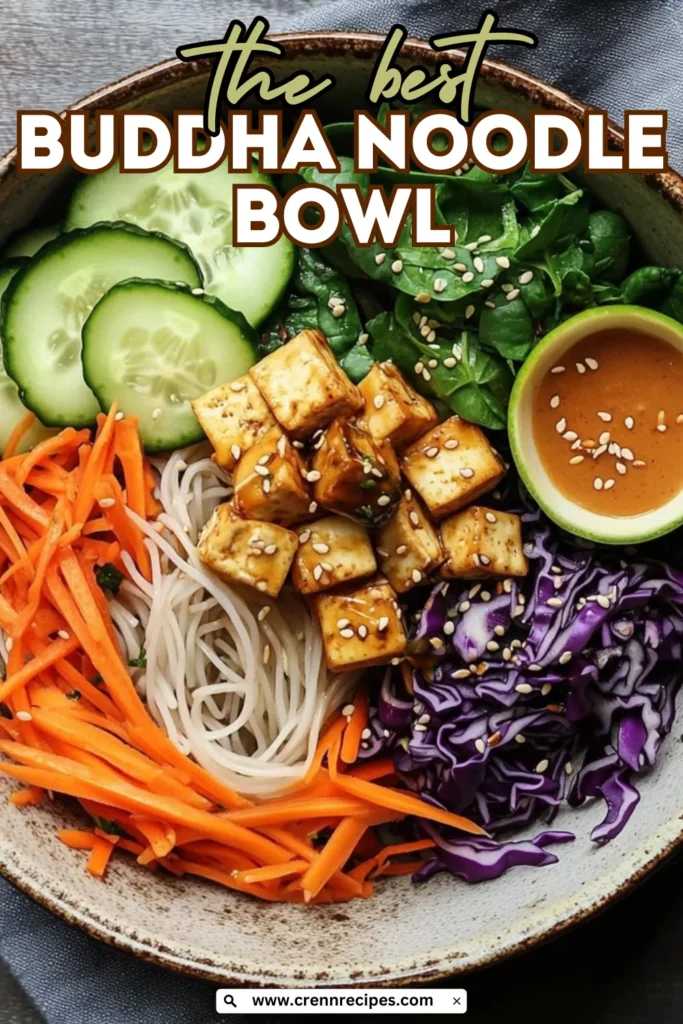
Make-Ahead and Storage Tips
One of the greatest advantages of Buddha Noodle Bowls is their make-ahead potential. Here’s how to prep efficiently and store leftovers properly:
Advance Preparation Strategies
For busy weeknights, consider this prep timeline:
Weekend prep (2-3 days ahead):
- Make the peanut-ginger sauce and store in an airtight container in the refrigerator
- Press and cube the tofu, storing it in an airtight container lined with paper towels
- Julienne carrots, slice bell peppers, and prepare other hardy vegetables
Night before or morning of:
- Cook and oil the noodles, storing them in an airtight container
- Pan-fry the tofu (it reheats wonderfully and maintains texture)
- Slice cucumber and any other delicate vegetables
Just before serving:
- Assemble all components
- Add fresh herbs and garnishes
- Drizzle with sauce or serve it alongside
This approach takes a 40-minute recipe and breaks it into manageable chunks that can be done when you have pockets of time.
Proper Storage for Leftovers
If you have fully assembled Buddha Noodle Bowls leftover:
- Store in airtight containers in the refrigerator for up to 2 days
- Keep additional sauce separately for refreshing the bowls upon serving
- Add fresh herbs and a squeeze of lime when reheating to revive flavors
For unassembled components:
- Cooked noodles: 3-4 days refrigerated in an airtight container
- Pan-fried tofu: 3-5 days refrigerated
- Cut vegetables: 2-4 days depending on the type
- Peanut-ginger sauce: 5-7 days refrigerated
Reheating Recommendations
Buddha Noodle Bowls are actually delicious cold or at room temperature, but if you prefer them warm:
- Microwave method: Heat for 60-90 seconds at 70% power to avoid overcooking the vegetables
- Stovetop method: Quickly stir-fry the noodles and tofu with a splash of water, then add fresh raw vegetables after heating
Remember that some vegetables like cucumber and cabbage are best added fresh after reheating, as their texture changes significantly with heat.
Nutrition Profile and Benefits
Beyond being delicious, Buddha Noodle Bowls offer impressive nutritional benefits that make them a wholesome choice for any meal:
Macronutrient Balance
A typical serving of our Buddha Noodle Bowl provides an excellent balance of:
Carbohydrates: The rice noodles deliver energy-providing complex carbohydrates that fuel your body and brain.
Protein: With approximately 15-20 grams per serving from the tofu and smaller amounts from the peanut butter, these bowls keep you satisfied longer than many vegetarian options.
Healthy Fats: The combination of sesame oil in the noodles and peanut butter in the sauce provides heart-healthy unsaturated fats that aid in vitamin absorption and contribute to satisfaction.
Fiber: From the abundance of fresh vegetables and whole-grain noodles (if using alternatives like soba), you’ll get 6+ grams of fiber per serving to support digestive health.
Micronutrient Highlights
The colorful array of vegetables contributes an impressive vitamin and mineral profile:
Vitamin A: Present in high amounts from the carrots and spinach, supporting eye health and immune function.
Vitamin C: Abundant in red bell peppers (which actually contain more vitamin C than oranges!), supporting collagen production and immune health.
Iron: Found in the spinach and tofu, though the vitamin C-rich components enhance its absorption.
Calcium: Present in the tofu and dark leafy greens for bone health.
Potassium: Found in several vegetables, helping maintain healthy blood pressure.
Dietary Adaptations
Buddha Noodle Bowls are remarkably adaptable to various dietary needs:
Gluten-free: The recipe is naturally gluten-free when using certified gluten-free tamari instead of soy sauce.
Vegan: Simply swap the honey for maple syrup in the sauce.
Low-carb: Substitute spiralized zucchini or shirataki noodles for the rice noodles.
Higher protein: Add an extra portion of tofu or incorporate edamame beans.
This flexibility makes Buddha Noodle Bowls perfect for families with varied dietary preferences or for meal prep when you’re cooking for one.
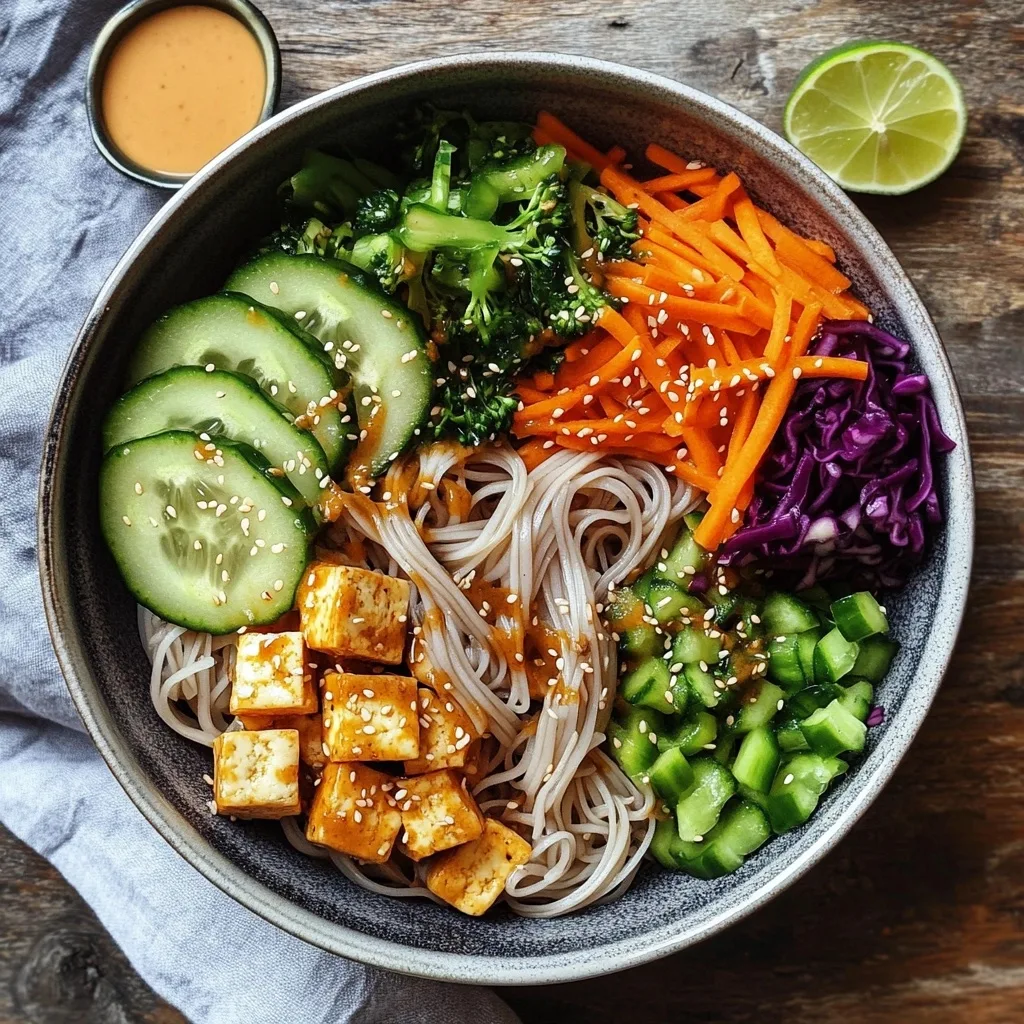
Variations to Keep It Fresh
The basic Buddha Noodle Bowl template offers endless possibilities for customization. Here are some inspired variations to keep this dish in regular rotation without boredom:
Seasonal Adaptations
Spring: Add asparagus, snow peas, and radishes with a lighter, lemon-forward sauce.
Summer: Incorporate fresh corn kernels, cherry tomatoes, and basil with a sesame-lime dressing.
Fall: Feature roasted butternut squash, kale, and pomegranate seeds with a miso-maple sauce.
Winter: Include roasted Brussels sprouts, sweet potato, and a warming tahini-turmeric sauce.
Global Flavor Profiles
Japanese-Inspired: Swap the peanut sauce for a simple miso-ginger dressing, add edamame and pickled ginger, and consider soba noodles as your base.
Thai-Inspired: Enhance the peanut sauce with red curry paste, add Thai basil, and incorporate lime leaves for authentic flavor.
Korean-Inspired: Create a gochujang-based sauce, add kimchi, and top with a fried egg for a fusion bibimbap-style bowl.
Mediterranean-Inspired: Use a tahini-lemon sauce, chickpeas instead of tofu, and add olives, cucumber, and cherry tomatoes.
Protein Swaps
For nights when you want something different:
- Substitute marinated grilled chicken for a crowd-pleasing option
- Try quick-seared shrimp for seafood lovers
- Use thinly sliced marinated steak for a heartier variation
- Explore tempeh for a different plant-based texture
The beauty of these variations is that once you master the basic template of the Buddha Noodle Bowl, you can adapt it to whatever ingredients you have on hand or whatever flavors you’re craving—making it both an economical and versatile addition to your cooking repertoire.
Why Buddha Noodle Bowls Are Perfect for Family Dinners
Beyond their flavor and nutritional benefits, Buddha Noodle Bowls offer practical advantages that make them ideal for family meals:
Customization Potential
Buddha Noodle Bowls naturally solve the common family dinner dilemma—different preferences. By setting out components separately, family members can create their own perfect bowl:
- Picky eaters can focus on their preferred vegetables
- Heat-sensitive family members can skip the spicy elements
- Bigger appetites can load up on noodles and protein
- Health-conscious members can emphasize the vegetables
This build-your-own approach fosters independence while ensuring everyone gets a meal they’ll enjoy.
Hands-On Engagement
There’s something inherently engaging about assembling your own Buddha Noodle Bowl. For families with children, this interactive element:
- Creates natural conversation opportunities around the table
- Encourages children to try new ingredients in a low-pressure way
- Develops fine motor skills and food awareness
- Makes mealtime more than just eating—it becomes an activity
Consider setting out components buffet-style and letting everyone create their own bowl, admiring each other’s creations before eating.
Leftovers That Transform
Perhaps uniquely among family dinners, Buddha Noodle Bowl components can easily transform into different meals:
- Extra sauce becomes a marinade for tomorrow’s protein
- Leftover vegetables can go into morning omelets
- Remaining noodles become the base for a quick soup
- Unused tofu can be scrambled for breakfast burritos
This adaptability reduces food waste and extends your cooking efforts across multiple meals.
Frequently Asked Questions About Buddha Noodle Bowls
Q: Can I make the peanut sauce without a blender or food processor? A: Absolutely! Simply whisk the ingredients together in a bowl, starting with the peanut butter and adding liquid ingredients gradually. For the smoothest results, make sure your peanut butter is at room temperature before mixing.
Q: How do I get my tofu crispy without deep-frying? A: The key is removing excess moisture. Press your tofu between paper towels with a weight on top for at least 30 minutes before cooking. Use a hot pan with enough oil to coat the bottom, and most importantly—don’t move the tofu too soon! Let it develop a crust before flipping.
Q: Are Buddha Noodle Bowls always vegetarian? A: Traditionally, Buddha Bowls tend to be plant-based, but there are no strict rules. Feel free to incorporate your protein of choice, whether that’s chicken, beef, shrimp, or fish.
Q: How can I make this more filling without adding more noodles? A: Add sources of healthy fats and protein! Consider adding avocado slices, a fried egg on top, or additional nuts and seeds, which provide satiety without excessive carbohydrates.
Q: What if I don’t like cilantro? A: Simply omit it or substitute with fresh mint, Thai basil, or even flat-leaf parsley. Each herb will bring a different profile to the dish, but all work beautifully with the other flavors.
Q: Can I make this spicier? A: Definitely! Add sriracha or sambal oelek to the sauce, increase the crushed red pepper flakes, or include thinly sliced fresh chili peppers as a topping.
Q: How do I prevent rice noodles from sticking together? A: Three key steps: don’t overcook them (they continue cooking after draining), rinse thoroughly with cold water immediately after cooking, and toss with a small amount of oil while still warm.
Q: Is this recipe good for meal prep? A: It’s excellent for meal prep! Store components separately and assemble just before eating. The sauce actually improves after a day in the refrigerator as flavors meld.
More Related Recipes You Might Enjoy
If you love this Buddha Noodle Bowl, you’ll also enjoy these other balanced, nutritious bowl meals from our collection:
Mediterranean Quinoa Bowl – Featuring protein-rich quinoa, roasted vegetables, and a zesty lemon-tahini dressing that pairs beautifully with our Buddha Bowl concept.
Quinoa Black Bean Bowl – A Southwestern twist on grain bowls with hearty black beans, avocado, and a lime-cilantro drizzle that offers similar customization options.
Classic Buddha Bowl – Our traditional take on the Buddha Bowl concept with roasted chickpeas, a variety of vegetables, and a versatile tahini sauce that complements this noodle version.
Each of these recipes follows the same philosophy as our Buddha Noodle Bowl—balanced nutrition, beautiful presentation, and endless adaptability to your preferences and available ingredients. They’re perfect for expanding your repertoire of healthy, satisfying meals that please both the eye and the palate.
In the end, the Buddha Noodle Bowl isn’t just a recipe—it’s a template for mindful eating that celebrates fresh ingredients, balanced nutrition, and the joy of creating something both beautiful and delicious. Whether you follow our recipe exactly or use it as inspiration for your own unique creation, we hope it brings nourishment and satisfaction to your table.
Print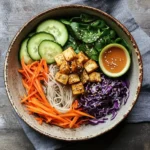
Buddha Noodle Bowl: 7 Incredible Secrets for the Ultimate Meal
- Total Time: 40 minutes
- Yield: 4 servings 1x
- Diet: Vegetarian
Description
This vibrant Buddha Noodle Bowl combines tender rice noodles, crispy pan-fried tofu, and a rainbow of fresh vegetables, all brought together with a creamy peanut-ginger sauce. It’s a perfect balance of textures and flavors in one beautiful bowl – customizable, nutritious, and ideal for meal prep!
Ingredients
- 8 oz rice noodles (or your favorite noodle)
- 2 tablespoons toasted sesame oil, divided
- 1 block (14 oz) extra-firm tofu, pressed and cubed
- 1 carrot, julienned or shredded
- 1 small cucumber, thinly sliced
- 1 red bell pepper, thinly sliced
- 2 cups baby spinach (or baby kale)
- ½ cup shredded purple cabbage (optional, but pretty!)
- 2 green onions, thinly sliced
- ¼ cup fresh cilantro, roughly chopped
- 2 tablespoons sesame seeds (toasted, if you’ve got ’em)
- Lime wedges, for serving
Peanut-Ginger Sauce:
- ⅓ cup creamy peanut butter
- 3 tablespoons low-sodium soy sauce
- 2 tablespoons honey (or maple syrup for vegan)
- 1 tablespoon rice vinegar (or lime juice)
- 1 teaspoon fresh ginger, grated
- 1 clove garlic, minced
- 2–4 tablespoons warm water (to thin, as needed)
- Pinch crushed red pepper (optional, for a little kick)
Instructions
- Cook your noodles: Bring a large pot of salted water to a boil. Add the rice noodles and cook according to package directions (usually 4–6 minutes). Drain, rinse under cold water, then toss with 1 tablespoon of sesame oil so they don’t stick. Set aside.
- Pan-fry the tofu: In a large skillet over medium-high heat, warm the remaining 1 tablespoon of sesame oil. Add the cubed tofu in a single layer. Let it sizzle undisturbed for 3–4 minutes until golden on the bottom, then gently flip and brown all sides, about 6–8 minutes total. Season with a pinch of salt and pepper. Remove from heat.
- Whip up the sauce: In a medium bowl, whisk together the peanut butter, soy sauce, honey, rice vinegar, grated ginger, minced garlic, and crushed red pepper. Stream in warm water, one tablespoon at a time, until you reach a smooth, pourable consistency. Taste and adjust—maybe a splash more vinegar for tang, or a drizzle more honey for sweetness.
- Assemble the bowls: Divide your noodles among four bowls. Arrange the tofu, carrot, cucumber, bell pepper, spinach, and cabbage in little sections over the noodles—it’s like a colorful rainbow on your plate!
- Dress and garnish: Drizzle your peanut-ginger sauce generously over each bowl. Sprinkle on green onions, cilantro, and sesame seeds. Serve with lime wedges on the side for a bright, fresh squeeze.
Notes
- For meal prep: Store components separately and assemble just before eating. The sauce actually improves after a day as flavors meld!
- Protein variations: Try with grilled chicken, sautéed shrimp, or thinly sliced steak instead of tofu.
- Noodle options: Works beautifully with soba noodles, udon, ramen, or even zucchini noodles for a lower-carb option.
- Extra crunch: Add chopped peanuts or cashews for additional texture.
- Time-saving tip: Use pre-pressed tofu (often labeled as “super firm”) to skip the pressing step.
- Prep Time: 25 minutes
- Cook Time: 15 minutes
- Category: Main Dish
- Method: Pan-Fry, Assemble
- Cuisine: Asian-Inspired
Nutrition
- Serving Size: 1 bowl
- Calories: 425
- Sugar: 12g
- Sodium: 485mg
- Fat: 18g
- Saturated Fat: 3g
- Unsaturated Fat: 14g
- Trans Fat: 0g
- Carbohydrates: 52g
- Fiber: 6g
- Protein: 17g
- Cholesterol: 0mg

